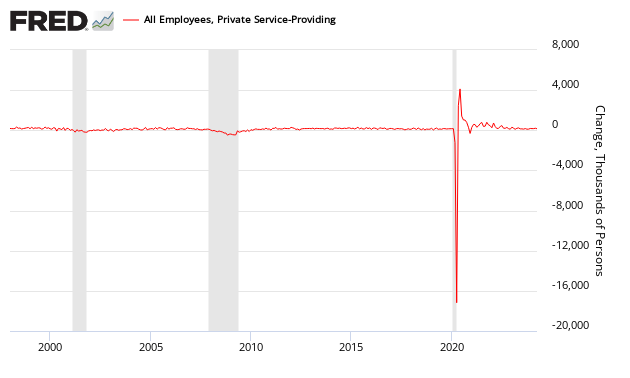Written by Steven Hansen
 The September 2014 ISM non-manufacturing (aka services) index continues its growth cycle, but insignificantly declined from 59.6 to 58.6 (above 50 signals expansion). Important internals likewise contracted insignificantly.
The September 2014 ISM non-manufacturing (aka services) index continues its growth cycle, but insignificantly declined from 59.6 to 58.6 (above 50 signals expansion). Important internals likewise contracted insignificantly.
This was above the range of market forecasts of 57.2 to 59.9 (consensus 58.8).
There are two sub-indexes in the NMI which have good correlations to the economy – the Business Activity Index and the New Orders Index – and both have good track records in spotting an incipient recession. The Business Activity Index insignificantly declined and the New Orders Index insignificantly declined – but both remain in territories associated with strong expansion.
This index and its associated sub-indices are fairly volatile – and one needs to step back from the data and view this index over longer periods than a single month.
The Business Activity sub-index declined 2.1 points and now is at 62.9.
ISM Services – Business Activity Sub-Index

The New Orders Index lost 2.8 and is currently at 61.0.
ISM Services – New Orders Sub-Index

The complete ISM manufacturing and non-manufacturing survey table is below.

Econintersect does give serious consideration to this survey as the service sector accounts for 80% of the economy and 90% of employment. However, this an opinion survey and is not hard data.
From the ISM report:
Economic activity in the non-manufacturing sector grew in September for the 56th consecutive month, say the nation’s purchasing and supply executives in the latest Non-Manufacturing ISM® Report On Business®.
The NMI® registered 58.6 percent in September, 1 percentage point lower than the August reading of 59.6 percent. This represents continued growth in the non-manufacturing sector. The Non-Manufacturing Business Activity Index decreased to 62.9 percent, which is 2.1 percentage points lower than the August reading of 65 percent, reflecting growth for the 62nd consecutive month at a slower rate. The New Orders Index registered 61 percent, 2.8 percentage points lower than the reading of 63.8 percent registered in August. The Employment Index increased 1.4 percentage points to 58.5 percent from the August reading of 57.1 percent and indicates growth for the seventh consecutive month. The Prices Index decreased 2.5 percentage points from the August reading of 57.7 percent to 55.2 percent, indicating prices increased at a slower rate in September when compared to August. According to the NMI®, 12 non-manufacturing industries reported growth in September. Respondents’ comments indicate that business seems to be leveling off and there is a slight slowing in the momentum of the past few months of strong growth. They continue to remain optimistic about business conditions and the overall direction of the economy.
INDUSTRY PERFORMANCE – The 12 non-manufacturing industries reporting growth in September — listed in order — are: Construction; Retail Trade; Utilities; Information; Health Care & Social Assistance; Transportation & Warehousing; Management of Companies & Support Services; Wholesale Trade; Professional, Scientific & Technical Services; Accommodation & Food Services; Real Estate, Rental & Leasing; and Finance & Insurance. The five industries reporting contraction in September are: Arts, Entertainment & Recreation; Mining; Educational Services; Public Administration; and Other Services.
Caveats on the use of ISM Non-Manufacturing Index:
This is a survey, a quantification of opinion. However, as pointed out above, certain elements of this survey have good to excellent correlation to the economy for as long as it has been in existence. Surveys lead hard data by weeks to months, and can provide early insight into changing conditions.
The main ISM non-manufacturing index (NMI) is so new that it does not have enough data history to have reliable certainty about how it correlates to the economy. Again, two sub-indices (business activity and new orders) do have good correlation for the limited history available.
No survey is accurate in projecting employment – and the ISM Non-Manufacturing Employment Index is no exception. Although there are some general correlation in trends if you stand far enough back from this graph, month-to-month movements have not correlated well with the BLS Service Sector Employment data.
ISM Services Employment Sub-Index vs BLS Non-Farm Services Employment

Related Posts:
Old Analysis Blog | New Analysis Blog |
| All Articles on Institute of Supply Management Surveys | All Articles on Institute of Supply Management Surveys |







